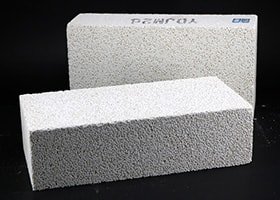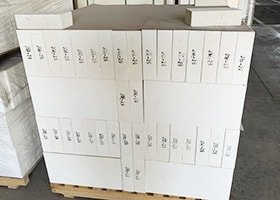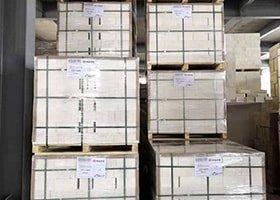Thermal insulating refractory bricks refer to refractories with high porosity, low bulk density and low thermal conductivity. Insulating refractory is also called light refractory. It includes heat insulation refractory products, refractory fiber and refractory fiber products.
The characteristics of Thermal insulating refractory bricks are high porosity, generally 40% - 85%; The bulk density is low, generally less than 1.5g/cm3. The thermal conductivity is lower than 1.0W (m·K). It can be used as thermal insulation material of industrial furnace, which can reduce heat loss of furnace, save energy and reduce the quality of thermal equipment. Thermal insulation refractory has poor mechanical strength, wear resistance and slag erosion resistance, so it is not suitable for bearing structure of furnace and directly contacting slag, burden, molten metal and other parts.
Thermal insulating refractory bricks refer to refractory products with porosity not less than 45%. There are many kinds of heat insulation and refractory products, and their classification methods are mainly as follows:
(1) According to the service temperature, it can be divided into low temperature insulating refractory (service temperature is 600-900 ℃), medium temperature insulating refractory (service temperature is 900-1200 ℃) and high temperature insulating refractory (service temperature is more than 1200 ℃).
(2) According to the bulk density, it can be divided into general lightweight thermal insulating refractory bricks (bulk density is 0.4-1.0g/cm3) and ultra lightweight thermal insulating refractory bricks (bulk density is less than 0.4g/cm3).
(3) According to the raw materials, it can be divided into clay, high alumina, silica and magnesia.
(4) According to the production method, it can be divided into burn out method, foam method, chemical method and porous material method.
(5) According to the shape of products, it can be divided into shaped heat insulation refractory products and amorphous heat insulation refractory products.
The manufacture of Thermal insulating refractory bricks is different from that of compact refractory products. The main methods are burnout addition, foam, chemical and porous materials.
(1) Burnout addition method. In this method, combustible or sublimable additives such as sawdust are put into the mud, mixed evenly, and then molded by extrusion, semi dry or slurry casting, dried and fired. Combustible or sublimable additives burn off in the process of firing, leaving empty holes and becoming heat insulation and refractory products.
(2) foam method. The method is to mix the foam agent into the foaming machine and add water to prepare a fine and uniform foam. Then the foam is added to the slurry to form a foam slurry. The model is injected into the slurry and dried together with the model. The mold is fired at 1320 ~ 1380 degrees (for high alumina refractory bricks) and processed.
(3) Chemical method. It is a method to obtain porous brick by using chemical reaction to produce gas in brick making process. Commonly used chemical reactions such as carbonate and acid, metal powder with acid, caustic soda and aluminum powder. The available chemical reaction must be controlled by the slow gas generation, otherwise the bubble will disappear when the injection mold is tilted. If the reaction is too fast, inhibitors such as hydrogen peroxide and manganese dioxide can be added. A stable foam slurry was mixed into the slurry of fine powder raw material and injected into the model. After drying, it was fired. The porosity of pure oxide insulating refractory products can reach 55% - 75%.
(4) Porous material method. This method uses natural light raw materials such as expanded perlite, expanded vermiculite and diatomite as raw materials, through various kinds of artificial hollow spheres as raw materials, adding a certain amount of binder, and through mixing, forming, drying and firing processes to make heat insulation and refractory products.





 Wechat Us
Wechat Us